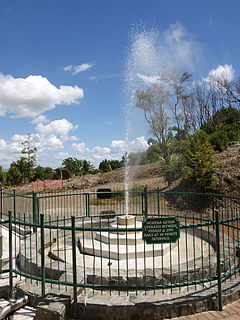Mokena Geyser
Mokena Geyser is one of two cold water geysers foundin the southern hemisphere . It is located in the town of Te Aroha on the North Island of New Zealand . The other geyser can be found in the city of Caxambu , Brazil .
geography
The Mokena Geyser is located on the northeastern edge of the city of Te Aroha at the foot of the long-extinct former volcano Mount Te Aroha . The city itself is just under 60 km northeast of Hamilton and around 50 km south of Thames on the western flank of the Kaimai Range in the Waikato region .
description
The Mokena belongs to a small hydrothermal system in the catchment area of Mount Te Aroha . The system, of which 28 exist in the Waikato region , now includes three springs that are capable of carrying water under pressure upwards, one of which is the Mokena . The geyser was created by drilling into the hydrothermal groundwater system in 1936, which was then piped. Since then, the Mokena has been discharging at 40 minute intervals. The water comes from a depth of around 105 m and produces around 28,000 liters of crystal clear water per day with a temperature between 75 and 85 ° C. The resulting fountain can go up to 5 m high.
The functioning of the Mokena Geyser is based on the pressing of the groundwater by the gas carbon dioxide , which collects in the ground and in the water and, when a threshold value is reached, leads to the eruption of the water-gas mixture. With the Mokena Geyser, this takes place at a CO 2 concentration of 2.5 g / kg of liquid.
history
The area around today's Te Aroha originally belonged to the Māori tribe of the Marutuahu and was used by them for hunting. The Māori knew the carbonated springs. They thought that the springs would have a connection to the sea via a tunnel through Mount Te Aroha . In 1869 the land on which the sources were, after an armed conflict with the Ngati Haua strain of the Maori land Court to Ngati Haua slammed, 1879 but the decision for a revision Marutuahu returned.
When the first gold fields were developed in Waiorongomai in 1880 , the Europeans came to found Te Aroha on November 25, 1880 and showed interest in the sources. A year later, gave Maori - chief , Te Mokena Hau 20 acre land on which the sources were. In 1882 the donation became valid when it was published. The first baths were built, which the Maori could use freely and free of charge according to the contract. The water was not only used for bathing, but was also valued as medicinal water for drinking. In 1886 the Te Aroha Soda And Mineral Water Company was founded, which filled and sold the water in bottles and even presented it to the public two years later at the exhibition for the centenary in Melbourne .
In 1938, one of the springs was drilled to a depth of 105 m and the hole was cased to a depth of 67 m. From this borehole, the carbonated water gushed out at intervals in the form of a fountain up to a height of 5 m. The geyser was thus created after Māori - Chief Mokena Te Hau named.
Today the water of the Mokena Geyser is almost entirely used for the bathhouse nearby. The geyser is only activated once a day for tourists between 12:00 p.m. and 2:00 p.m. and is then presented at 40-minute intervals.
literature
- J. Alan Glennon : The Operation and Geography of Carbon Dioxide-Driven, Cold-Water “Geysers” . In: The GOSA Transactions . Volume IX . University of California , Santa Barbara 2004, pp. 184–192 (English, online ( memento of October 13, 2014 in the Internet Archive ) [PDF; 69 kB ; accessed on June 23, 2014]).
- J. Ding, J. Leaver, A. Watson : Application of Fourier and Analyzes to Pressure Data from the Te Aroha Hydrothermal System . In: 21th New Zealand Geothermal Workshop . University of Auckland , Auckland 1999, pp. 211–216 (English, online PDF 479 kB [accessed on June 23, 2014]).
- The chemistry of waters of Te Aroha geothermal system . In: Waikato Regional Council (Ed.): Waikato Regional Council Technical Report . tape 2013/07 , October 2012, ISSN 2230-4355 (English, online [PDF; 2.5 MB ; accessed on June 23, 2014]).
Individual evidence
- ↑ Geiser Floriano de Lemos . Descubra Caxambu , accessed January 17, 2018 (Portuguese).
- ^ A b Glennon : The Operation and Geography of Carbon Dioxide-Driven, Cold-Water “Geysers” . 2004, p. 185.188 .
- ↑ a b c Waikato Regional Council (Ed.): The chemistry of waters of Te Aroha geothermal system . 2012, History of the system , p. 2-5 .
- ↑ a b Ding, Leaver, Watson : Application of Fourier and Analyzes to Pressure Data from the Te Aroha Hydrothermal System . Auckland 1999, p. 211 (English).
- ↑ Walks - Mokena Geyser . Te Aroha , accessed May 2, 2019 .
- ↑ Waikato Regional Council (ed.): The chemistry of waters of Te Aroha geothermal system . 2012, The Resource , pp. 12-14 .
- ↑ a b Mokena Geyser Access . Matamata Piako District Council , accessed January 10, 2015 .
